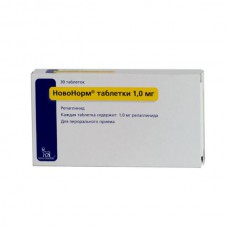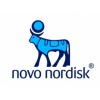Expiration date: 09/2025
Release form and composition:
Tablets. 1 tablet contains:
Repaglinide 0.5 mg
Excipients: poloxamer 188, povidone, meglumine, corn starch, calcium hydrogen phosphate anhydrous, cellulose microcrystalline (E460), glycerol 85%, the polyacrylate potassium (potassium polacrilin), magnesium stearate.
15 PCs. - blisters (2) - packs of cardboard.
Tablets. 1 tablet contains:
Repaglinide 1 mg
Excipients: poloxamer 188, povidone, meglumine, corn starch, calcium hydrogen phosphate anhydrous, cellulose microcrystalline (E460), glycerol 85%, the polyacrylate potassium (potassium polacrilin), magnesium stearate, colorant iron oxide yellow (E172).
15 PCs. - blisters (2) - packs of cardboard.
Tablets. 1 tablet contains:
Repaglinide 2 mg
Excipients: poloxamer 188, povidone, meglumine, corn starch, calcium hydrogen phosphate anhydrous, cellulose microcrystalline (E460), glycerol 85%, the polyacrylate potassium (potassium polacrilin), magnesium stearate, colorant iron oxide red (E172).
15 PCs. - blisters (2) - packs of cardboard.
Pharmacological action:
Oral rapid acting hypoglycemic drug. Rapidly lowers blood glucose by stimulating insulin release from functioning beta cells of the pancreas. The mechanism of action is associated with the ability of the drug to close ATP-dependent channels in the membranes of beta cells due to the impact on specific receptors, leading to depolarization of the cells and opening the calcium channels. The result is an increased calcium influx induces insulin secretion from the beta cells.
After ingestion the insulinotropic response to a meal occurs within 30 min, which leads to a decrease in the level of glucose in the blood. In periods between meals not marked increase in the concentration of insulin. In patients with insulin-dependent diabetes mellitus (type II) before the drug in doses from 0.5 to 4 mg observed dose-dependent decrease in the level of glucose in the blood.
Pharmacokinetics:
Suction
Once inside Repaglinide is rapidly absorbed from the gastrointestinal tract, with Cmax achieved within 1 h after administration, and then Repaglinide in plasma decreases rapidly after about 4 hours becomes very low. Was not observed clinically significant differences in pharmacokinetic parameters Repaglinide when taking right before a meal, for 15 and 30 minutes before meals or on an empty stomach.
Distribution
The plasma protein binding is more than 90%.
Vd is 30 l (consistent with distribution into intracellular fluid).
Metabolism and excretion
Repaglinide biotransformiroetsa almost completely in the liver to form inactive metabolites. Repaglinide and its metabolites are excreted mainly in bile, with less than 8% - with urine (as metabolites), less than 1% from faeces (unchanged). T1/2 approximately 1 h.
Indications:
- non-insulin dependent diabetes mellitus (type II).
Dosing regimen:
The mode set individually, selecting a dose with the goal of optimizing glucose levels.
The recommended starting dose is 500 micrograms.
Increase dose should be no earlier than 1-2 weeks of continuous use, depending on the laboratory parameters of carbohydrate metabolism.
The maximum single dose 4 mg, maximum daily dose of 16 mg.
When switching from other hypoglycemic drug for Novonorm the recommended starting dose is 1 mg.
Novonorm should be taken before each main meal. The optimal time of drug intake for 15 minutes before a meal, but can be taken 30 minutes before meals or just before eating.
Side effects:
Side effects associated with the influence on carbohydrate metabolism: hypoglycemic state (paleness, increased sweating, palpitations, sleep disorders, tremor) fluctuations in the level of glucose in the blood can cause temporary visual acuity, especially at the beginning of treatment (it was noted in a small number of patients and did not require discontinuation of the drug).
From the digestive system: abdominal pain, diarrhea, nausea, vomiting, constipation and in some cases - increase in liver enzymes.
Allergic reactions: itching, erythema, urticaria.
Contraindications:
- insulin-dependent diabetes mellitus (type I)
- diabetic ketoacidosis (coma condition)
- severe renal dysfunction
- severe disturbances of liver function
- concomitant treatment with drugs inhibiting or inducing CYP3A4
- pregnancy (including planned)
- lactation (breast feeding)
- hypersensitivity to the drug.
Pregnancy and lactation:
Adequate and well-controlled studies of the safety of Repaglinide during pregnancy have not been conducted, therefore the use of the drug is not recommended.
During pregnancy, during childbirth and in the postpartum period may be significant changes in the state of carbohydrate metabolism that requires careful medical monitoring of patient's condition and the transfer to insulin.
If necessary, use repaglinida in the lactation period should solve the issue of termination of breastfeeding.
In experimental studies found that the teratogenic effect is missing, however, in applying the drug in high doses in rats in the last stages of pregnancy was observed embryotoxicity, impaired development of the limbs in the fetus.
Repaglinide is excreted in breast milk.
Special instructions:
In the case of liver disease or kidney disease, major surgery or recent illness, or infection control over the content of blood glucose and duration of diabetes in patients receiving drug Novonorm may be lost.
In applying the drug in patients with kidney disease should be aware that total clearance Repaglinide in the plasma is reduced. Dose patients with kidney disease should be interpreted with caution (due to increased sensitivity to insulin).
Clinical studies safety of the drug in patients older than 75 years and in patients with hepatic impairment were not conducted.
In debilitated patients or patients of low power starting and maintenance doses should be the minimum required careful selection of doses for the prevention of hypoglycemic reactions.
Occurring hypoglycemic States usually are the reactions of moderate severity and easily dealt with by intake of carbohydrates. In severe conditions may need to be on/in the introduction dekstrozy (glucose). The probability of such reactions depends on individual factors such as dietary habits, drug dose, intensity of physical activity and stressful situations.
There is no reason to assume the possibility of cross-allergic reactions with sulfonylureas due to the different chemical structure.
Be aware that beta-blockers may mask symptoms of hypoglycemia.
Patients receiving Novonorm, should refrain from alcohol because the ethanol may enhance and prolong the hypoglycemic effect Repaglinide.
Effects on ability to drive vehicles and management mechanisms
Patients should be warned of the precautions to avoid hypoglycemia while driving vehicles. This is especially important for patients with insufficient knowledge of symptoms of hypoglycemia or frequent hypoglycemic reactions. In such circumstances, should assess the feasibility of driving a car or doing other potentially hazardous activities.
Overdose:
Symptoms: may develop hypoglycemic state.
Treatment: when symptoms of hypoglycemia the intake of carbohydrates inside a more severe hypoglycemia with convulsions, loss of consciousness and development of coma should be to stop by I/V administration of glucose.
Drug interactions:
While the use of hypoglycemic effect of the drug Novonorm can potentiate MAO inhibitors, nonselective beta-blockers, ACE inhibitors, salicylates, NSAIDs, octreotide, ethanol and anabolic steroids.
While the use of hypoglycemic effect of the drug Novonorm can weaken hormonal contraceptives for oral administration, thiazide diuretics, corticosteroids, danazol, thyroid hormones and sympathomimetics (at the time of appointment or cancellation of these drugs must carefully monitor the status of carbohydrate metabolism).
While the use of the drug Novonorm with drugs that are mainly excreted with the bile, you should consider the potential interaction between them.
Pharmacokinetic interaction
In connection with the data on Repaglinide metabolism by cytochrome CYP3A4 should be considered a possible drug interaction Novonorm with CYP3A4 inhibitors (ketoconazole, itraconazol, erythromycin, fluconazole, mibefradil), leading to increased levels Repaglinide in plasma.
Drugs that induce CYP3A4 (rifampicin, phenytoin) may reduce the concentration of Repaglinide in plasma. Since the value of the inducing effect is unknown, the combined use of the drug Novonorm with these drugs is contraindicated.
Terms and conditions of storage:
The drug should be stored in original packaging in a dry place. Shelf life - 4 years.



